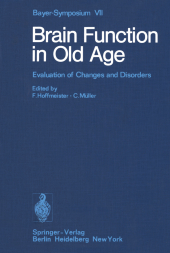 Neuerscheinungen 2011Stand: 2020-01-07 |
Schnellsuche
ISBN/Stichwort/Autor
|
Herderstraße 10
10625 Berlin
Tel.: 030 315 714 16
Fax 030 315 714 14
info@buchspektrum.de |

F. Hoffmeister, H. P. Krause, C. Müller
(Beteiligte)
Brain Function in Old Age
Evaluation of Changes and Disorders
Mitarbeit: Krause, H. P.; Herausgegeben von Hoffmeister, F.; Müller, C.
Softcover reprint of the original 1st ed. 1979. 2011. xi, 533 S. XI, 533 pp. 82 figs., 46 tabs. 244 mm.
Verlag/Jahr: SPRINGER, BERLIN 2011
ISBN: 3-642-67306-6 (3642673066)
Neue ISBN: 978-3-642-67306-1 (9783642673061)
Preis und Lieferzeit: Bitte klicken
Held at Grosse Ledder near Cologne, Germany, October 18-20, 1978
Experimental gerontopsychology attempts to test causal hypotheses about old age-related behavioral changes by the manipulation of age-differences. An experimental treatment is introduced with the purpose of equating different age-groups with respect to a potentially relevant function. If the treatment results in an assimilation of the behavior of the different age-groups (age by-treatment interaction), differences in this function are con sidered as causal for the normally observed behavioral differ ence. If it does not result in an assimilation of the behavior of the different age-groups (main effect of treatment), differ ences in this function are considered as irrelevant for the nor mally observed behavioral difference. The different interpretations of age-by-treatment interactions and main effects of treatment in this kind of research are reasonable only if the experimental treatment actually results in an equalization of the age-groups with respect to the func tion of interest. As is shown, such a functional equalization can neither be demonstrated nor assumed in many cases. In such cases, studies with either age-group can be used to investigate hypotheses about potential causes for old age-related behavioral changes, studies with young subjects having important advantages over studies with old subjects. A test of causal relationships by age-by-treatment interactions is possible in cases where the experimental treatment evidently results in an equalization of the age groups with respect to the function in question. Unfortunately, the field of application for this kind of approach is rather limited.


